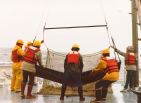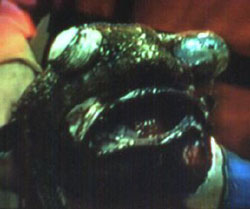Home > Ocean > Exploring the Deep > Deep Sea Trawling
Exploring the Deep: Trawling
Scientists learn about deep ocean creatures in several different ways. The easiest (and least dangerous to the scientists) is by collecting specimens from the ocean using a technique called trawling. It's a form of old-fashioned fishing where a large, tapered, flattened fishing net is lowered into the water and dragged along behind a powerful ship. It takes hours to lower the net to the bottom and then hours more to bring it back up, depending on the depth of the water.
The specimens that were gathered in the trawl are removed immediately upon reaching the surface so they can be photographed, measured, dissected, and preserved before they begin to decay. Most creatures that live in the deep ocean are specially adapted to living under the extreme atmospheric pressure of the ocean depths. As they are raised to the surface on the trawl the depressurization that the creatures experience during ascent usually kills them. Some of the more delicate ones just completely disintegrate.
 The photo below is an example of the effects of depressurization during ascent when deep ocean creatures are brought up to the surface. When a fish is hooked/caught by a fisherman at great depths (>100ft) and brought to the surface, the external pressure around the fish decreases causing bubbles to form inside the fish as the gases in their swim bladders expand. These bubbles will cause problems throughout the fish resulting in gas bladder (swimbladder) inflation, pop-eye, and internal hemorrhage/bleeding (and no, the fish does not survive these injuries). This is one of the many reasons that fish (vertebrates) that exist in the ocean depths cannot be brought to the surface and kept alive in aquariums (like the Monterey Bay Aquarium, for example). The photo below is an example of the effects of depressurization during ascent when deep ocean creatures are brought up to the surface. When a fish is hooked/caught by a fisherman at great depths (>100ft) and brought to the surface, the external pressure around the fish decreases causing bubbles to form inside the fish as the gases in their swim bladders expand. These bubbles will cause problems throughout the fish resulting in gas bladder (swimbladder) inflation, pop-eye, and internal hemorrhage/bleeding (and no, the fish does not survive these injuries). This is one of the many reasons that fish (vertebrates) that exist in the ocean depths cannot be brought to the surface and kept alive in aquariums (like the Monterey Bay Aquarium, for example).
What is an undersea submersible? ->

(Photos courtesy of Paul Yancey, Biology Dept., Whitman College, Walla Walla Washington)
|
Get Your Degree!
Find schools and get information on the program that’s right for you.
Powered by Campus Explorer
|

